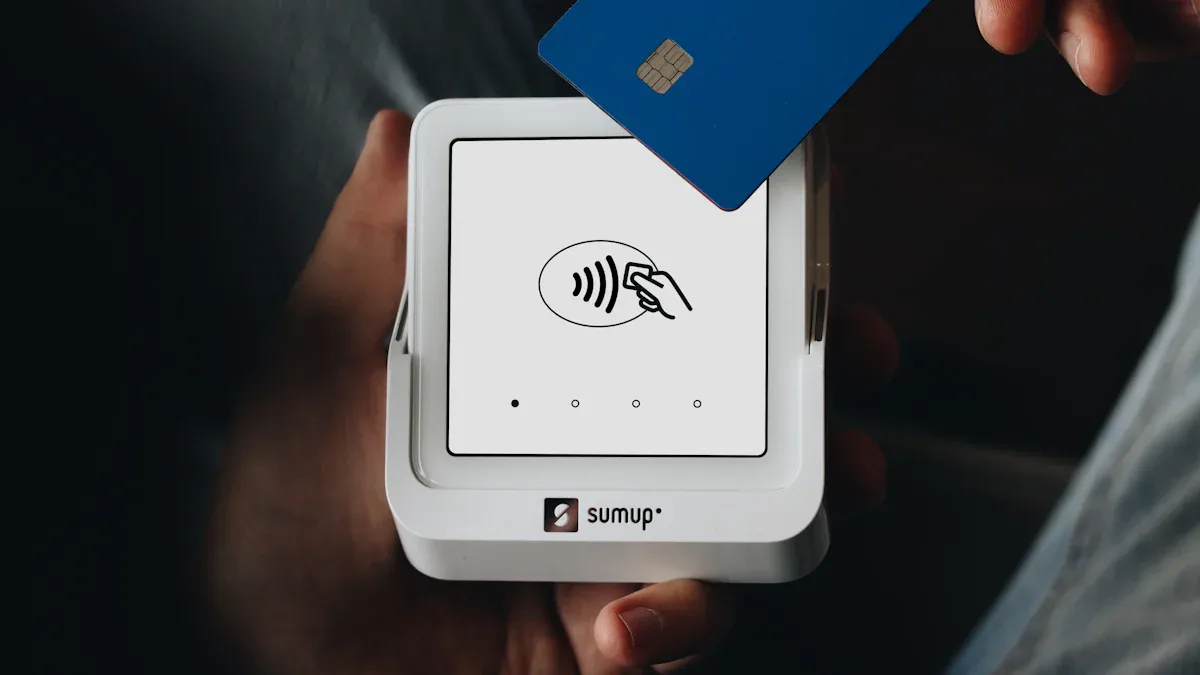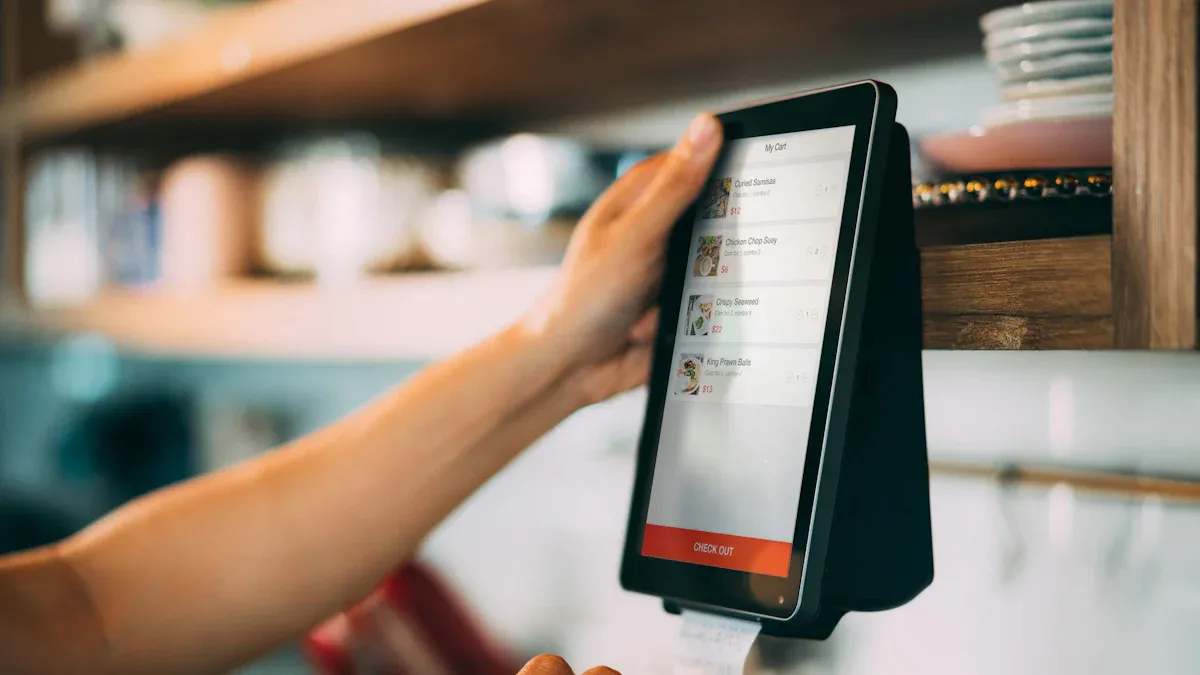Vending Machine Innovations in 2025 Driven by AI Payment Systems

Hunan Xingyuan’s AI-powered fridge vending machines change how people use automated retail. These machines have smart features for keeping track of items. They also give people personal experiences. Devomech’s Mini Market solution shows how AI turns old vending units into new retail hubs. Many users now use a ‘Tap, Grab & Go’ process. This makes buying snacks quick and simple. Operators get real-time stock tracking and automatic reordering. This cuts down on manual work and keeps shelves stocked.
Key Takeaways
AI-powered vending machines let people pay without cash or touching anything. This makes buying things fast and safe.
Many people use mobile wallets like Apple Pay and Google Pay. These are popular because they are easy to use.
Facial recognition technology makes shopping feel special for each person. It remembers what you like and makes paying faster.
Smart inventory management helps keep favorite items in the machine. This means less waste and happier customers.
Predictive maintenance and remote monitoring help machines work well. This means they break down less and customers are happier.
AI Payment Systems in Vending Machines

Cashless and Contactless Payments
AI payment systems make buying from vending machines easier. People can pay by tapping their card or phone. This way is quick and simple. In 2024, most vending machine sales in the U.S. were cashless. The number of cashless sales grew a lot from last year. Many people used contactless cards to pay. Mobile wallets like Apple Pay and Google Pay were used for most cashless sales.
Cashless and contactless payments help keep people safe. People do not need to use cash, so theft is less likely. These payments also help keep things clean. People do not have to touch the same surfaces. Card readers use EMV chip technology to keep data safe. Contactless ways like NFC and mobile wallets add more security. People do not need to swipe cards.
Cashless and contactless payments have many good points:
They lower theft and vandalism.
They fit what people want for digital payments.
They make buying snacks and drinks faster.
They help keep vending machines clean and safe.
Mobile Wallets and Digital Currency
Mobile wallets are a popular way to pay at vending machines. Many people use their phones to buy things fast. In 2025, Apple Pay, Google Pay, and Samsung Pay are the top choices. The table below shows which wallets are most used:
Mobile Wallets | Popularity in Vending Machines |
|---|---|
Apple Pay | |
Google Pay | Leading option |
Samsung Pay | Leading option |
Many users like wallets because they are easy and quick. About 41% of people pick wallets for this reason. More than half of people avoid stores that do not take digital wallets. PayPal, Google Pay, Apple Pay, and Samsung Pay are the most used for digital payments. PayPal is the top choice, with 69% of users. Google Pay has 56%, Apple Pay has 53%, and Samsung Pay has 52%.
AI payment systems like Nayax and Parlevel Payplus help operators see sales and stock right away. These systems turn vending machines into smart retail spots. Operators can see what sells best and when to restock. This helps them make better choices and give better service.
Note: Cashless sales now make up 62 percent of vending machine sales. This shows more people are using digital payments.
AI payment systems keep changing vending machines. They make buying things easier, safer, and better for everyone.
Personalization and User Experience

Facial Recognition and Customer Identification
Facial recognition changes how people use vending machines. Cameras take pictures of faces. Sensors know when someone is near the machine. Machine learning looks at these pictures to find out who the person is. The system remembers people who come back. It also remembers what they like to buy. It can show words in the language the person likes. Facial recognition makes paying fast and safe.
Tip: Facial recognition lets people buy snacks without typing passwords or swiping cards. This makes buying easy and safe.
Privacy is a big concern with these new tools. The table below lists some main problems with facial recognition in vending machines:
Key Issue | Description |
|---|---|
Unauthorized Data Collection | Vending machines tracked age and gender without user consent. |
Lack of Consent | Users were not informed about data collection practices. |
Breach of Privacy Rights | Personal information was collected without proper notice. |
Operators need to follow the law and tell people how their data is used. Being open and honest helps people trust the machines.
Product Recommendations
Smart vending machines use data to see what people buy. The system learns which snacks and drinks people like most. It suggests things based on what people bought before. This helps customers find what they want faster. The machine keeps popular items in stock, so people are happy.
92% of workers say having good tools makes their jobs better.
76% think personalization is important at work.
Personalized suggestions help sell more and make people happier. Businesses get more repeat customers when they offer choices that fit people’s likes. The vending machine changes with new tastes and trends, so shopping is easier for everyone.
Smart Vending Machine Features
Inventory Management
AI helps vending machines know what products they have. Machine learning studies old sales and trends. The system guesses what people will buy next. Operators use this to refill shelves before things run out. Smart vending machines change stock levels when demand goes up or down. They also pick good spots for each product. This means less waste and full shelves.
Evidence Description | Source Link |
|---|---|
AI-driven systems change stock levels when demand changes. | |
Machine learning predicts demand by looking at past data. | |
AI lets vending machines change inventory and pick good spots. | |
AI guesses what people want and refills shelves. | |
AI looks at lots of data to help manage inventory. |
Tip: AI inventory management helps operators keep popular snacks and drinks in stock.
Predictive Maintenance
AI helps operators keep vending machines working well. Predictive maintenance uses data to find problems early. Operators fix things before machines break. This saves money and keeps machines ready for customers. Data helps operators know when parts need fixing. The system checks how machines work and warns about problems. This means less downtime and longer machine life.
Operators see fewer surprise breakdowns. Customers find machines working most of the time. Predictive maintenance helps businesses work better.
Remote Monitoring
Remote monitoring lets operators check vending machines from anywhere. Computer vision and sensors send updates about stock and health. Operators get alerts when products are low or machines need fixing. Real-time checks help find problems fast. Automated messages remind operators to refill shelves. Predictive maintenance stops breakdowns and keeps machines running longer.
Feature | Impact on Efficiency |
|---|---|
Real-time checks | Finds problems early, so machines work more. |
Automated messages | Reminds operators to refill, so products are always there. |
Predictive maintenance | Stops breakdowns, so machines last longer. |
Fewer service calls | Drops by 82%, so machines work better. |
Note: Remote monitoring helps operators handle many machines at once. This makes work easier and keeps customers happy.
Benefits for Users and Operators
Convenience and Speed
AI payment systems make buying snacks very fast. People tap their phones or cards to pay. They get their food or drinks in just a few seconds. There is no need to carry cash or wait for change. Operators see shorter lines and happier customers. Many people pick vending machines because they save time. Quick payments help students, workers, and travelers get what they need fast.
Tip: Fast payments mean more sales and less waiting for everyone.
Efficiency and Profitability
Operators use smart tools to watch sales and refill items early. Machines send alerts when stock is low or needs fixing. This stops wasted trips and keeps shelves full. AI helps operators plan better and spend less on repairs. Profits go up as machines work longer and sell more things. The table below shows how smart vending machines make more money than old ones:
Type of Vending Machine | |
|---|---|
Traditional Vending | $100 - $500 |
Smart Vending | $500 - $2,000 |
Smart vending machines help businesses earn more and serve more people.
Enhanced Engagement
AI-powered vending machines learn what people like to buy. They suggest snacks and drinks based on past choices. Customers feel special when machines remember their favorites. Operators see more repeat buyers and higher sales. Personalized offers and messages keep people coming back. Smart features make shopping fun and easy.
Users get custom suggestions.
Operators build loyalty and boost sales.
Both groups enjoy a better experience.
Challenges and Solutions
Security and Privacy
Smart vending machines use AI payment systems to collect customer data. This can cause new security problems. Hackers want to steal important information from these machines. Operators worry about data leaks, viruses, and online attacks. Updating security often helps keep machines safe.
Main security risks include:
Data leaks and privacy problems can show customer details.
Viruses and hacking mess up machines and take data.
Online attacks let criminals control machines from far away.
Operators need strong encryption and must update software often. Staff should learn how to spot strange activity. Cybercrime now targets vending machines and other easy services. About 75% of cyber attacks hit small businesses. Ransomware can stop machines, so strong security is needed.
Adoption Barriers
Businesses have problems when using AI payment systems. High costs make it hard for small companies to upgrade. Technical problems like bad connections and software bugs slow things down. Fixing machines adds more trouble.
Common barriers include:
High costs for new hardware and software.
Connection and software problems.
Worries about data safety and privacy.
Old technology needs upgrades and training.
Privacy worries come with facial recognition. Operators must fix these problems to build trust and follow rules.
Compliance Issues
Rules decide how companies use AI payment systems. Laws like CCPA and GDPR say machines must protect customer data. Money rules help keep payments safe and legal. AI systems must be clear, fair, and easy to understand.
Compliance Requirement | Impact on AI Vending Machines |
|---|---|
Data protection laws | Safe handling of important information |
Financial regulations | Legal and safe payment steps |
Transparency | Fair and clear AI choices |
Regulators want to know how AI makes choices. Companies that show fairness and honesty can do better than the rules. Meeting these rules helps operators avoid fines and earn customer trust.
Future Trends in Vending Machines
Sustainability Initiatives
Many companies want vending machines to be better for the planet. They use packaging that can break down or be recycled. Solar-powered machines use sunlight to save energy. Operators add energy-saving modes and better cooling systems. This helps the environment. New technology gives out products carefully. This stops too much packaging and makes sure items are used before they go bad. Data analytics guess what people will buy next. Operators fill machines with what people want, so less gets wasted. Some smart vending machines give rewards when customers return used packaging. This helps people recycle and reuse more.
Packaging that breaks down or can be recycled
Machines powered by sunlight
Ways to save energy
Careful product giving
Smart ways to manage stock
Rewards for recycling and reusing
Many smart vending machines help the planet and teach people about being green.
Market Growth
The market for vending machines with AI is getting bigger. Experts think it will grow a lot next year. The table below shows how much the market will be worth in 2025.
Year | Market Size (US$) | CAGR (%) |
|---|---|---|
2025 | 12.8 |
This means more people want smart and easy vending machines. Businesses buy new technology to keep up and make customers happy.
Emerging Technologies
New technology is changing vending machines. Remote monitoring lets operators see sales and stock right away. AI and machine learning help make shopping special for each person. Cashless payments are now normal. This makes buying things quick and easy.
AI and machine learning for personal shopping
Cashless payments for easy buying
Technology | Description |
|---|---|
Machines use AI to suggest products and manage stock. | |
Cashless Payment Systems | People pay with phones, cards, or cryptocurrency. |
Touchless Interfaces | QR codes and apps help keep things clean and fast. |
Facial Recognition | Machines know who you are and suggest things you like. |
Remote Monitoring | Operators check sales and stock from anywhere. |
Personalized Consumer Experience | Machines change what they offer based on what people like. |
Smart vending machines have sensors and screens.
Real-time data helps operators refill machines fast.
Data analytics show what people like and how they shop.
Technology keeps making vending machines smarter and better for everyone.
AI payment systems and personalization have changed vending machines in 2025. Operators use live data to keep track of products and give special choices. Customers pay fast and get suggestions just for them. Businesses make more money and connect better with people. The first users found that meeting customer needs and using smart tools brings good results.
Trend | Description |
|---|---|
Machines say hello and suggest items right away. | |
Sustainability | Solar power and no-waste models help the earth. |
Digital ads | Kiosks show ads that match each user’s profile. |
Emerging markets | Solar and mobile tools help reach new places. |
Smart vending machines will keep getting better, adding new things and making shopping nicer for everyone.
FAQ
What is an AI payment system in vending machines?
An AI payment system uses smart software to handle payments. It takes cards, mobile wallets, and digital currency. The system learns what people buy. It helps operators keep track of sales.
How does facial recognition work in vending machines?
Cameras look at faces when people get close. The system checks faces with saved profiles. It finds out who the user is. It suggests products the person might like.
Are AI vending machines safe for personal data?
AI vending machines use encryption to keep data safe. Operators follow privacy laws like GDPR and CCPA. They update security often to protect information.
Can vending machines accept cryptocurrency?
Many smart vending machines take cryptocurrency. People pay with digital wallets using Bitcoin or other coins. The system handles these payments fast.
See Also
Exploring AI-Enhanced Vending Machines: Advantages for Today's Retail
The Role of Vending Machines in Fast Food Automation
Modern Vending Machines: Key Features and Their Benefits
Vending Machines Through Time: From Snacks to Smart Tech
Transforming Retail: The Impact of Smart Electronics Vending Machines
